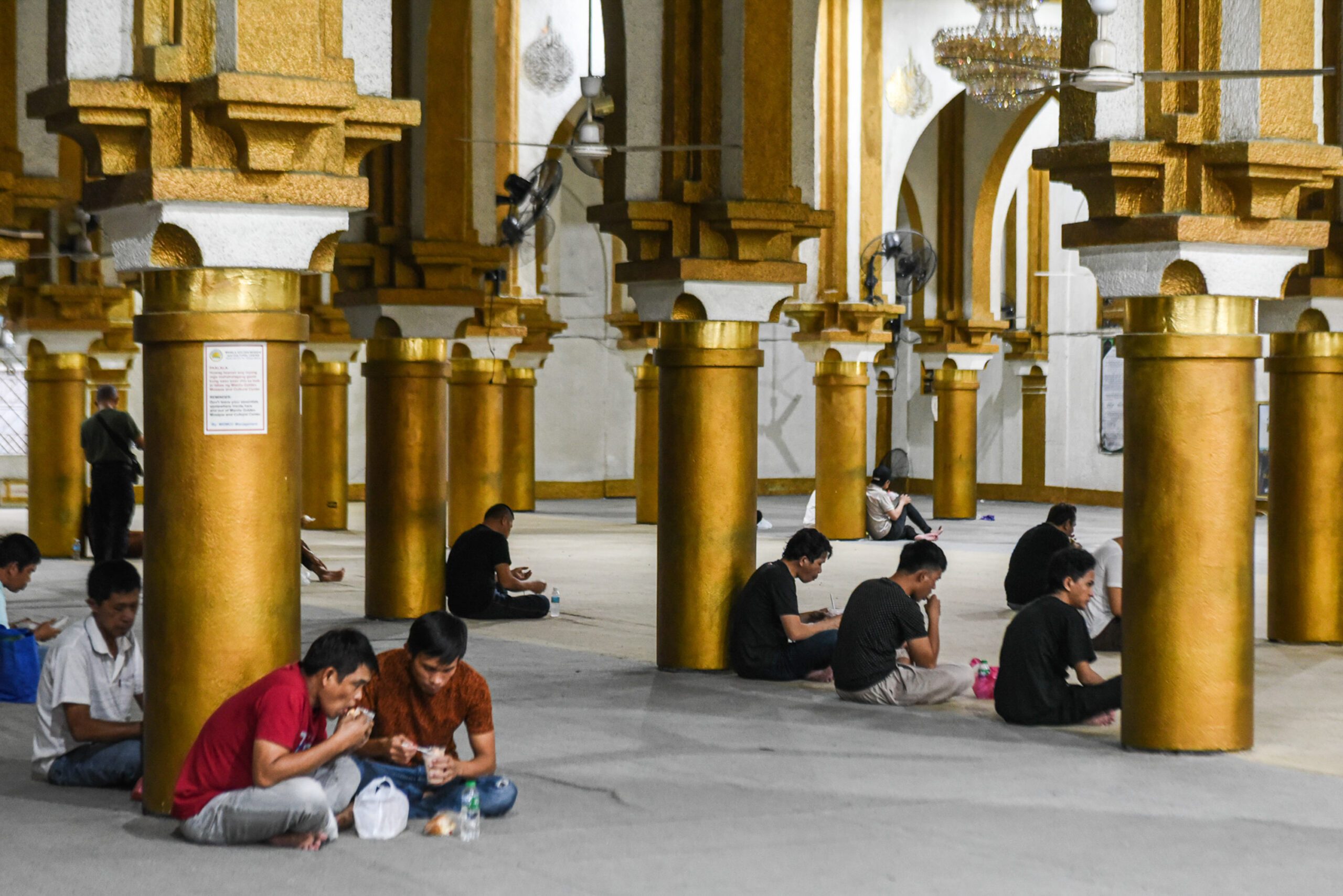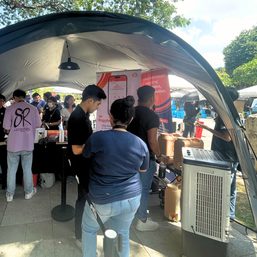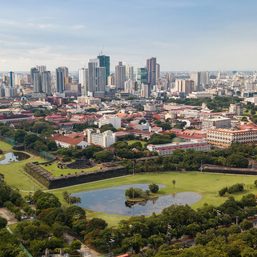SUMMARY
This is AI generated summarization, which may have errors. For context, always refer to the full article.

To many, the hustle, bustle, chaos, and color of Quiapo is the quintessence of Manila, the Philippine capital.
You may know it as the crazy market district, home to historic Quinta Market and a plethora of stalls selling everything from cheap wedding decor, to medicinal herbs, to anting-anting (amulet or charm). It encompasses the route of the famous Black Nazarene procession, but also has a thriving Muslim community surrounding the Golden Mosque, the largest Philippine mosque outside of Mindanao.
F.R. Hidalgo Street, known to photography enthusiasts for its many camera shops, was once called the most beautiful street in Manila because of the stately arcades of homes that lined it.
Given all of Quiapo’s unique attributes, many have pushed for protection and conservation of the area. In recent months, progress has been made, with the House of Representatives passing House Bill No. 8664, a bill that seeks to declare Quiapo a heritage zone. It is authored by the representative of the district that covers Quiapo, Joel Chua.
In the Senate, a similar bill, No. 2324, authored by Senator Loren Legarda, is still being discussed at the committee level. But on April 30, Legarda called for a hearing with Chua, heard from heritage advocates, conservation experts, and Quiapo property owners, and agreed to create a technical working group to work on the bills.
Legarda and Chua spoke about their bills and the obstacles that line the path to their passage into law during a Be The Good episode last May 10.

Some major thorny points are the need to balance conservation of historic structures with economic development, and the geographic extent of the heritage zone declaration.
Here’s what you need to know.
Geographic coverage

The two bills still differ in geographic coverage. The House Bill covers “the immediate environs of Quiapo Church, Plaza Miranda, San Sebastian Church, Plaza del Carmen, Quezon Bridge, the Life Theatre or Old Villongco Building, and other built heritage with notable historical and cultural significance.”
The Senate bill, in its filed version, declares the broader “Quiapo district” as a heritage zone, but also lists down specific historic structures needing protection.
The bill applies to “all cultural properties,” including historical shrines and monuments, archaeological and traditional ethnographical materials, works of national heroes, structures and archival materials “dating at least 50 years old” within Quiapo district.

According to Chua, a broader heritage zone declaration would have implications on Manila’s real property tax collection. Because in the House version, owners of buildings declared as historically significant would be exempted from real property tax collection. These tax perks have been cited by heritage advocates and property owners as a key incentive that ensures historic structures in private hands will be conserved and maintained.
“The question is, if we’re going to, let’s say, declare certain streets in Quiapo: four or five streets, like the Bilibid Viejo, the Arlegui, the De Guzman [streets], so will all the property owners in these streets avail of the tax incentives?” asked Representative Chua, whose district, full of historic places like Binondo and Escolta, contributes “more than half” of Manila’s income.
Zones within the zone
The House bill makes use of the concept of “core zones” and “buffer zones” within the Quiapo heritage zone. This was also pushed by heritage advocates during the April 30 hearing.
The distinction could address concerns about how heritage zone declaration could take away a big chunk of tax collection or would hinder development in the area. This is because strict regulations on building height, facade design, and provision of tax perks would be limited only to the core zones, while there would be more flexibility, both for private property owners and City Hall, in the buffer zones.

Manila to manage
Both the House and Senate bills will give Manila the role of managing the heritage zone. This is different from, for example, how Intramuros is managed by the Intramuros Administration, the national government agency under the tourism department.
This is why both bills require that the Manila City Council pass an ordinance operationalizing the heritage zone declaration. Both bills also state that Manila, in coordination with national agencies, craft a “heritage zone development plan” (Senate bill) and “conservation management plan” (House bill).
The House version asks the Manila City government to choose a site manager who, with assistance from the National Historical Commission, will conduct a cultural mapping of Quiapo and take charge of developing the site.
Enhancements of sidewalks, roads, signs
One way national government agencies will pitch in is by allocating some of their funds to infrastructure and facilities development inside the Quiapo heritage zone.
In both bills, the Department of Tourism is told to accord “priority development” to the district. It should be aided by the public works and highways department, and the Tourism Infrastructure and Enterprise Zone Authority. To ensure that enhancements will abide by regulations and standards of conservation and heritage preservation, the National Historical Commission and National Commission for Culture and the Arts must also help, say the bills.
The Senate version is explicit in stating that the city government and national government must ensure there is proper sewerage and waste disposal in Quiapo.
“Just as basic as cleaning the streets to make sure the esteros are clean, to ensure that garbage is collected in accordance with [the Ecological Solid Waste Management Act]…. Second, just lighting the streets, not with gaudy lamplights which some LGUs purchase, but something that is in accordance with the heritage of the place,” said Legarda during the Be The Good episode.
Other enhancements could be better street signs, better sidewalks, and the like.
Perks for property owners
One provision the House bill has that the current Senate bill does not have is a section stating that private properties declared as “Important Cultural Property” or “National Cultural Treasure” by the national government will be exempt from real property tax. If the property owner damages or changes the structure so much so that it destroys its heritage significance, they would be fined with back taxes.
Building owners and heritage advocates have long said tax perks like this are key to motivating the owners to maintain and preserve their buildings. Without such an incentive, it would be much easier for the owner to not petition for the designation of their building as historic and just demolish the building to make way for a more profitable structure.
This has led to the wipe out of many heritage buildings even before their full historic significance could be identified.

Robby Sylianteng, who belongs to a family who partly owns the historic First United Building in Escolta, said the tax perks are a big help. His family was able to use P2.5 million that would have otherwise gone to real property tax to pay for fiber internet for the entire building, he said during the Be The Good episode.
Tax perks could keep historic buildings alive, which would preserve the unique character of the district.
Legarda, however, said the impact on Manila’s tax collection means the provision would have to go through the Senate’s ways and means committee. This is one of the issues that will be hashed out by the technical working group.
A living zone
The tricky thing with heritage zone declarations is, if regulations go overboard, they could shut certain communities out and turn the area into a “museum” or “theme park.” In other words, efforts to preserve the historical character of a place could “freeze” the area in time, make it too expensive to live in, and bring it closer to another kind of death.
For instance, we asked Representative Chua how the bills would address the street vendors in Quiapo. Undoubtedly, the vendors must be regulated, given their impact on waste disposal, orderliness, and the movement of people and vehicles. But they are also part of what makes Quiapo vibrant and authentic. Shutting them out would be unjust and contrary to the essence of Quiapo as a melting pot.
Chua said he has incorporated the vendors in the overall design of the area. He mentioned the provision of a specific design of their carts and even uniforms for vendors that would be in keeping with Quiapo’s historical significance. He gave assurances that communities were consulted on this.
Still, it’s not clear what the fate of the Quiapo vendors would be under a heritage zone declaration. At the very least, both Senate and House bills state that communities and stakeholders are supposed to be consulted in the crafting of plans for Quiapo.
Heritage conservation can contribute to economic growth
Regulations that would naturally result from a heritage zone declaration may put a damper on some plans of real estate developers. Guidelines in Quiapo’s “core zone” would limit what property developers can do with historic buildings.
But Stephen Pamorada, a Manila heritage advocate and founder of The Heritage Collective, said the heritage zone declaration, if done right, will attract the right investors.
The trick, he said, is to see the declaration in terms of its potential to bring in economic growth.
“The prerequisite for stakeholders and developers in these places is, will you also be taking part in the journey to make sure we keep the character and historical significance of the place? Because if not, maybe go somewhere else?” said Pamorada during the Be The Good episode.
Chua cited the example of Vigan in Ilocos Sur, a heritage zone managed by the local government which has reaped much income for residents and communities as a top tourism destination.
A World Heritage site since 1999, it has been recognized for its “successful and sustainable management” achieved despite “relatively limited resources,” according to the United Nations.
Quiapo, with its dozens of built heritage, important religious landmarks, shopping areas, cultural traditions, and foodie attractions, has the potential to rival or even surpass Vigan.
Quiapo is just the start. Manila’s third district is also home to Binondo and Escolta, Santa Cruz, and San Nicolas. Chua hopes to declare these as heritage zones as well.
But the key is to do the Quiapo proposal well, and make sure communities are consulted every step of the way.
“Once an area has been declared and they see how beautiful and how sustainable and economically feasible it has been, the others would want to be declared eventually,” said Legarda. – Rappler.com
Balancing heritage conservation and economic development is one way groups say we can #MakeManilaLiveable. Rappler has a dedicated space for stories about improving quality of life in Metro Manila, and beyond. To learn more about the movement and take part in it, click here.
Add a comment
How does this make you feel?

![[Uncle Bob] No whores at the Oarhouse](https://www.rappler.com/tachyon/2024/06/oarhouse-june-28-2024-2.jpg?resize=257%2C257&crop=414px%2C0px%2C1080px%2C1080px)



There are no comments yet. Add your comment to start the conversation.